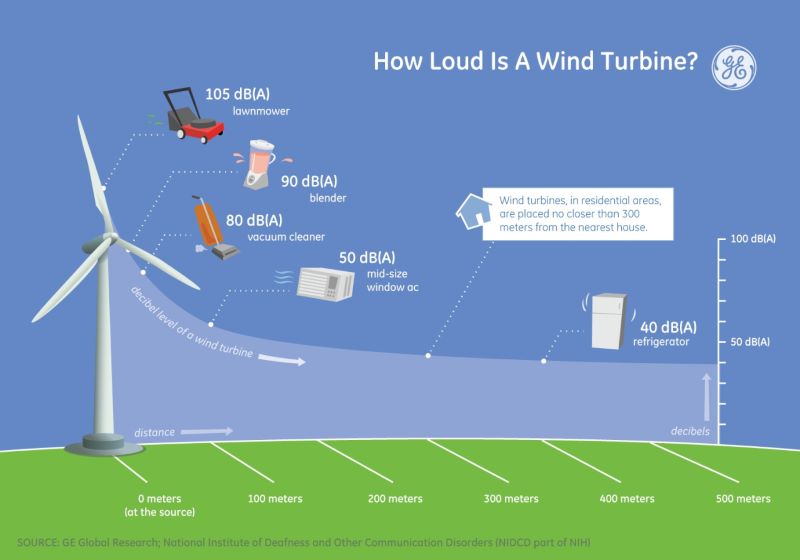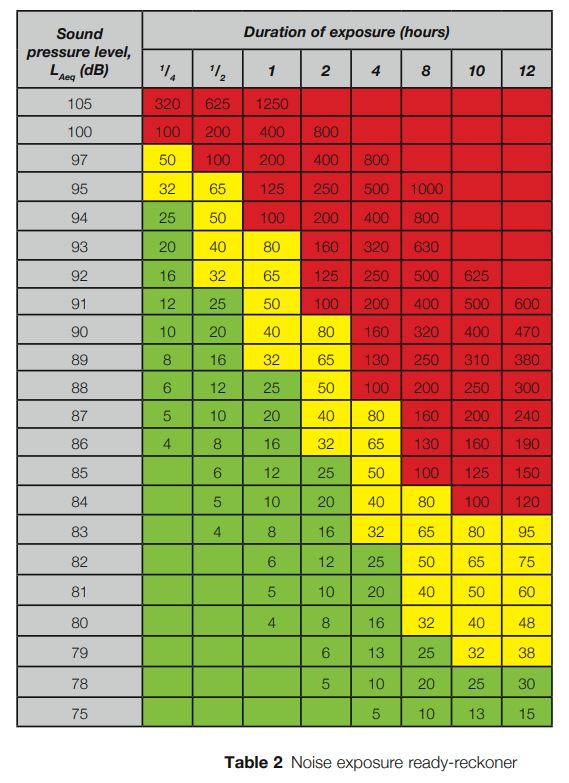During a speech on Tuesday April 2nd, Donald Trump, the President of the United States of America, seemed to declare that the noise from windmills (wind turbines) causes cancer. I don’t want to be accused of putting words in his mouth, so here is what he actually said:
“Hillary wanted to put up wind … If you have a windmill anywhere near your house, congratulations, your house just went down 75% in value. And they say the noise causes cancer…”
There was more to the statement than that, including a bit that I couldn’t make out. And then there was some talk about the high number of birds that are killed by windmills, including Bald Eagles. But, for this post, birds are beyond my remit. I’m interested in what his speech had to say in relation to the cancer causing properties of windmills.
So, Hillary Clinton has been very open about her desire to move the United States energy production more towards renewable energies like wind and solar. She said as much in her policy proposal on climate change. She’s also been quoted as saying, “I want more wind, more solar, more advanced biofuels, more energy efficiency“.
And when Clinton is talking about ‘wind’ she is talking about the energy producing wind turbines’

Photo by RawFilm on Unsplash
As such, when Trump refers to Clinton’s position on ‘wind’ he is also referring to wind turbines, even if calls them ‘windmills’. And, even though windmills and wind turbines are different things, I shall use ‘windmills’ in this post, for the purposes of consistency.

Photo by Jongsun Lee on Unsplash
Not that it particularly matters which of these wind-based machines Trump was actually referring to; as I shall explain, neither windmills nor wind turbines emit a noise that causes cancer.
And it’s far from just me reflecting on Trump’s words. His statement caused quite a stir across the various news outlets. It also led to any number of questions on Quora along the lines of, ‘Do windmills cause cancer?’ My answer was requested on a couple of these questions. In answering, I pointed out that the noise from wind turbines does not, in fact, cause cancer…
To be fair, though, my answers on Quora were based on the following series of assumptions:
- For a cancer to develop, there needs to be cell damage at the genetic level and I couldn’t see how noise could do this.
- The ear has evolved to deal with noise. I didn’t see how a noise source could cause damage to the DNA of the cells of the organ that specifically deals with noise.
- My impression was that the noise generated by windmills was not particularly loud.
- I didn’t think that there were people who were in a close enough proximity to windmills for any length of time.
But an argument from personal incredulity is no argument at all. There could well have been any number of other aspects to the noise emissions of windmills that I didn’t know about. In my defense, though, I knew I’d be writing this and would, then, do the appropriate research. So, if it turned out that I was wrong, I could always go back and amend my answers.
Spoiler alert: I wasn’t wrong. The noise from windmills cannot cause cancer.
Of course, I’m far from the first person, or site, to observe that the noise from windmills does not cause cancer. Politifact, the Pulitzer winning fact checking site, rated Trump’s statement as ‘Pants on Fire’ on its Truth-O-Meter. For anyone in any doubt, this rating relates to the schoolyard taunt, “Liar, liar, pants on fire!” Which is to say that Trump’s statement is demonstrably untrue.
Politifact’s basis for this rating is looking at the existing research and noting that there have been exactly zero links between the noise from windmills and cancer cases. But I’d like to go into this in a little more depth. Not least because, for some people, the lack of proof that something isn’t happening doesn’t mean it can’t happen. Which, of course, is perfectly true…
Additionally, it should be noted that there is plenty of opposition to windmills. Not least because they’re huge. Which means if there’s one anywhere near you, you’re going to know all about it. A windmill could well be the perfect modern example of the idiom, a blot on the landscape. Furthermore, they’re a lot louder than I expected them to be:

https://www.ge.com/reports/post/92442325225/how-loud-is-a-wind-turbine/
In hindsight, I suppose it’s obvious. The windmill is generating electricity; this is going to cause noise. 105 dB(A) is a dangerously high level of noise. It’s enough to cause pain if you’re exposed to it for any length of time. It’s not as high as going to a rock concert, which would be 110 dB but it’s more than a jackhammer, at 100 dB. And workers using a jackhammer should be wearing ear defenders…
But the level of 105 dB(A) is only if you’re pretty well hugging the windmill. By the time you get 100 meters away the noise level is down to 50 dB(A) and by 400 meters it’s only 40 dB(A). In most countries, housing is not permitted within 2-300 meters of a windmill. Let’s assume that the level in this zone is 48 dB(A), for argument’s sake.
This means that people living at 2-300 meters from a windmill could be exposed to a noise level of 48 dB(A) for 24 hours a day. And it is known that the impact of noise exposure is cumulative. The Health and Safety Executive have a table in their Guide to the Control of Noise at Work Regulations (L108). Admittedly, this relates to noise at work, not noise domestically, but it should offer an insight:
Now, decibel levels are funny things. Each increase of 3 d(B) is equivalent in a doubling of exposure. For example, in the bottom right hand corner of the table, for the 12 hour exposure level at 75 d(B), you will find the figure ’15’. The figure above this, for 12 hours at 78 d(B) is ’30’. A doubling. Likewise, if you scan up to where the 12 hour figure for 81 d(B) is, you’ll see it’s ’60’.
You’ll also see that the the 4-hour exposure figure for 75 d(B) is ‘5’. Doubling the exposure level to 8 hours also doubles this figure to ’10’. Tripling the 4-hour exposure to 12 hours also triples the figure to ’15’. You can see this principle applies across the whole table. So, to get 24 hours, we need to multiply the 4-hour exposure by six, which gives us a figure of ’30’. But, because it’s ongoing 24/7, I think it would be fair to double it again and achieve a figure of ‘120’. You only find a ‘120’ in the red, danger, zone.
But, of course, that’s for a level of 75 d(B). We’re interested in the exposure figure for a level of 48 d(B). That’s a difference of 27 d(B). And, because decibel levels double with every 3 d(B) increase, they also half with every 3 d(B) decrease. There are 9 lots of 3 d(B) in the 27 d(B) difference, which means we need to half our figure of 120, nine times. That gives a figure of, ‘0.23’.
Which is considerably lower than ‘4’, the lowest figure on the table. This is also why I haven’t gone into detail about what the figures on the table actually represent. There’s no point: there is no health risk, let alone a cancer risk, from the noise levels you’d get in your home from a windmill. Or, more accurately, in your garden. These noise levels would be significantly reduced even further by the walls and roof of a home.
Despite this, there is plenty of argument that the noise from windmills is damaging to health.

By fir0002flagstaffotos [at] gmail.comCanon 20D + Canon 70-200mm f/2.8 L – Own work, GFDL 1.2, https://commons.wikimedia.org/w/index.php?curid=1161749
There is even a name for these damaging health effects, Wind Turbine Syndrome…
Wind Turbine Syndrome (WTS) has been associated with a wide range of damage to health, including cancer and death.
However, when WTS has been actively researched, the science found neither cancer nor death. They did find, though; annoyance!
It turns out that living next to something that can emit an ongoing background drone can be annoying. Having lived next to a motorway (freeway), I can attest to the truth of this. But annoyance is not the same as significant health effects, which is why WTS is listed on Wikipedia as an example of pseudo-science. This puts WTS in the same category as Alternative Cancer Therapies, and we all know how I feel about them…
But there’s another angle of attack when it comes to windmills. Vibroacoustic Disease, brought on by Infrasound.
Vibroacoustic Disease is caused by the long term exposure (10 years +) to “large pressure amplitude (≥ 90 dB SPL) and low frequency noise (≤ 500 Hz).” As we’ve already established, we can rule out the loud sound levels, but what about low frequency noise?
Infrasound is, “sound that is lower in frequency than 20 Hz or cycles per second, the “normal” limit of human hearing.” And, yes, windmills are known to emit infrasound. This means that if Infrasound can cause Vibroacoustic Disease, then it’s possible for windmills to cause Vibroacoustic Disease. The issue is that while Vibroacoustic Disease is different to WTS, it also lists a vast array of symptoms and health effects.
But, the real problem with Vibroacoustic Disease is that virtually all of these symptoms and health effects are based on anecdotal evidence. Basically, people living close to windmills saying that they’re developing certain problems and then associating said problems with the windmills in question.
In contrast, the Wikipedia page in infrasound has a section on Human Reactions, which lists the following:
- “One study has suggested that infrasound may cause feelings of awe or fear in humans.“
- “A scientist working at Sydney University’s Auditory Neuroscience Laboratory reports growing evidence that infrasound may affect some people’s nervous system by stimulating the vestibular system.“
- “Research conducted in 2006 focusing on the impact of sound emissions from wind turbines on the nearby population, perceived infrasound has been associated to effects such as annoyance or fatigue.“
- “Later studies … have linked inaudible infrasound to effects such as fullness, pressure or tinnitus, and acknowledged the “possibility that it could disturb sleep.“
- “Other studies have also suggested associations between noise levels in turbines and self-reported sleep disturbances in the nearby population.“
- “In a study at Ibaraki University in Japan, researchers said EEG tests showed that the infrasound produced by wind turbines was ‘considered to be an annoyance to the technicians who work close to a modern large-scale wind turbine’.”
You will notice the remarkable lack of any mention of the word ‘cancer’ in this list of health effects from the low frequency noise from windmills…
Fortunately, there has been some more recent research in the field. In 2017, Sound and Vibration Magazine included the following article:
Health Effects from Wind Turbine Low Frequency Noise & Infrasound
Do Wind Turbines Make People Sick? That is the Issue.
http://www.sandv.com/downloads/1701hess.pdf
Which, I think, is pretty much right on the nose.
I’ve got to be honest, it’s a dense article and I haven’t read it all. The link is above, if anyone wants to… The conclusion, however, said the following: “Infrasound (IS, 0-20 Hz) from wind turbines can almost be ruled out as a potential mechanism for stimulating motion sickness symptoms.”
If you’re wondering why the article is focusing on motion sickness, it’s because that’s the limit of the health risks that science thinks that the noise from windmills can cause. And even motion sickness has, more or less, been ruled out. That said, the conclusion does go on to say that a couple more studies should be completed.
I had originally planned to go into detail on how the ear works and how damage at the genetic level is required to trigger cancer but there’s no point. It’s already clear that what Trump said was completely wrong.
The noise from windmills can not and does not cause cancer.

